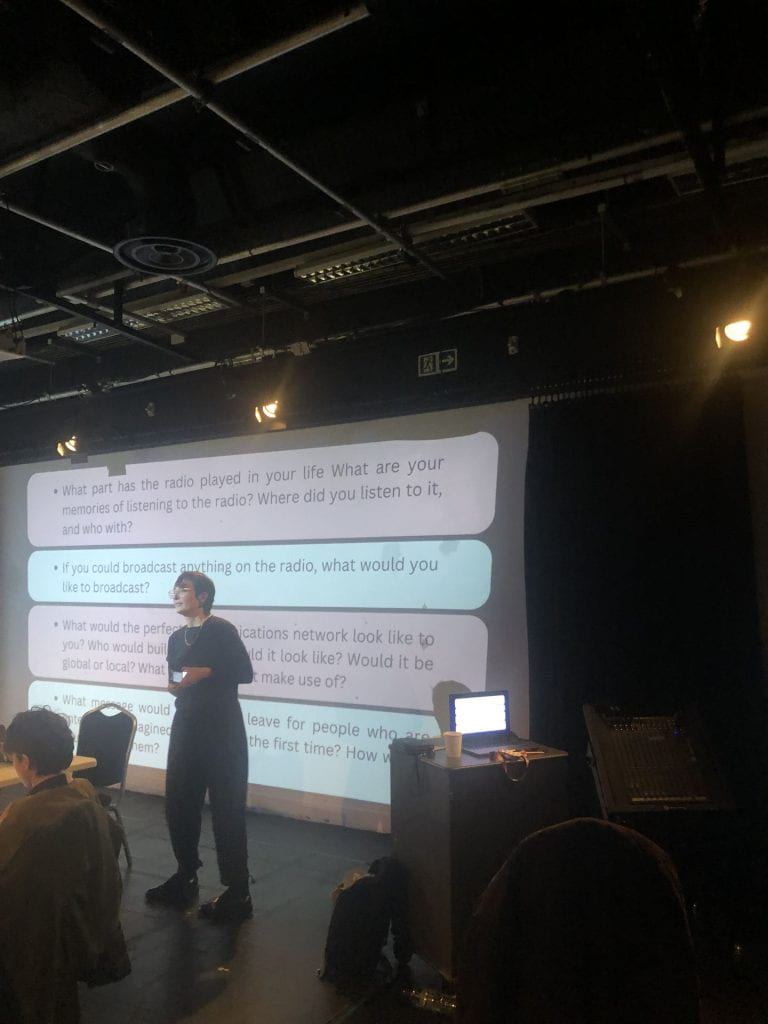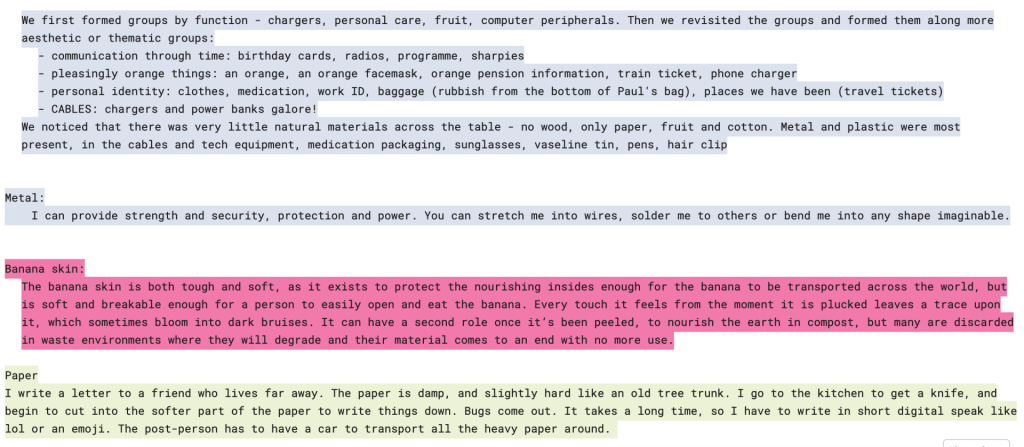Katy Dadacz and Francesco Bentivegna, partnered with Control Shift , ran a two-day weekender (25-26th November) exploring queer practices and creative technologies. The event took place at Wickham Theatre, and was generously funded by UoB (IAA Seedcorn Fund) and the Centre for Creative Technologies.
After a sunny and fresh (but cold) morning at Trans Pride South West, we headed up to Wickham Theatre to have lunch and begin our workshops. Participants ranged from PhD students, early career researchers, lecturers from the Faculty of Arts, Humanities, Innovation and Engineerng, creative practioners, game designers, artists and Pervasive Media Studio residents.
Harriet Horobin-Worley ran the first workshop ‘Sound and Vision- Building Our Own Networks’. We began asking ‘how are networks built’ and ‘what alternative forms of networks could exist?’ We drew out the networks that brought us here; the people who shared the event, the app which we got a ticket with, the places, institutions and communities that connected us with creative technology. We thought about the online/offline networks that we are in; Whatsapp groups, Slack, telegram channels, hiking groups, activist circles and queer book clubs. What do these structures allow for in terms of communication, desire, accessibility, social relations? Do we feel constrained or restricted, or do we feel connected? What alternative forms of networks could exist?
Harriet guided us through the ways we can use radio to imagine a future network; a radio built, owned, operated and used by queer people. Over time, radio has been used less and less as new technologies have appeared on the scene. Radio waves exist all around us, and we can use them to communicate, even more so than traditional FM radio stations. In pairs, participants audio-recorded their conversations answering the questions Harriet posed to the group.

What part has the radio played in your life What are your memories of listening to the radio? Where did you listen to it, and who with? If you could broadcast anything on the radio, what would you like to broadcast? What would the perfect communications network look like to you? Who would build it, what would it look like? Would it be global or local? What senses would it make use of? What message would you like to leave for people who are entering this imagined network for the first time? How would you welcome them?
Harriet is working on an art project in which these queer recordings will be used for a ‘radio hotline’; people can call in and listen, if they feel lonely, or want to feel closer to a queer community. We didn’t listen back to the recordings, but we will follow the project as it develops and keep sharing.
After a short break, MELT (Ren and Iz) led an exploration on queering the methods of workshops when thinking with digital practice. They began with a performance piece; bad workshop practices. Nobody but myself, Fran and MELT knew that this was a performance. The performance consisted of a chaotic introduction with loud music, reading quickly from a lot of text projected onto the wall, no introductions and lights switching on and off. Participants became ‘in on the joke’ slowly. This itself reminded me of how important humour is in building queer spaces. We see queer humour not only as a social tool to deconstruct binaries, but as a political tool for mobilisation and critique. Laughter allowed us to build connections and solidarity. The performance also allowed us to begin thinking through what happens when access needs are thrown out the door, when there is no time to settle in, or time to understand how we will be together in a space that tries to de-centre paradigms of privilege. Creating a context matters.
We began to deconstruct what methods are. We don’t often think about what it means for us though we use methods everyday- how do we set up a value based method or practice? We experimented with some of the ways MELT develops their own methods; collective conditions (how do we set up spaces intentionally together), practices of description and access, how we can write an access rider.
What makes collective conditions different from a code of conduct? When have we felt space in spaces? How can we embody the verbs of the collective conditions? What material agencies do the objects around us in the space have?

The second day began with Yudi Wu’s workshop on VTubing and queerness. How can VTubers ‘touch grass’ and help local communities, especially local queer communities? How can we create connections between the material and virtual with queer sociality in mind?
We split into pairs and did a quick design of what our online avatar would be based on a one minute description of each other. The beauty of the virtual is you are not limited to your human body. Yudi gave us a crash course in avatar and environment-creation in Unity. We spent some time thinking about what is missing in our own queer communities, and what a queer virtual activist could do to help. We thought about the importance of inclusivity, less age discrimination, low sensory spaces, DIY events, lack of space and safety, out of city centre events, a space to share stories, laws that protect queer people, awareness teams, genuine connection and hybrid meetings. We then turned to what a VTuber could do to help this by creating an avator and environment. Yudi proposed questions such as what would the avatar be? What would it look like? What’s the lore? What does the world look like? What type of content could they make? How would they engage and contribute to Bristol’s queer scene?
We imagined a queer alien elder living in a world technologically improved for queer needs. From this, one group began to create the avatar, which they named Genuine, whilst the other group began designing and creating the environment. The environment group mapped out some design features they would love to see such as a cat cafe, a soft play area, hills and hiking trails, talking animals, free translation AI, a terrace for collective dreaming and a social introducing robot, which you can see below along with the final avator and scenes from the environment.

After a thoughtful morning of speculative imagining, we ran an open forum where we reflected on the questions that drove us to create the workshops themselves.
What participatory pedagogies allow knowledge-exchanges centered around queerness? What agency is afforded to queer people when imagining future technological development? How can we develop creative practices that bring queerness to the forefront of re-inventing approaches to technology?
We reflected on the importance of framing, and connecting workshop spaces to community organising- which is why going to the trans pride march was so important. What will serve queer people, and what will exploit us? How can we hold the space for implicit knowledge for technology practices? How can we uphold consent based practice? We explored the importance of giving agency to queer people to make things together, and to build a capacity for imaging and doing. One way to do this is to emphasise that learning goes both ways; the workshops should not be hierarchal. The final point was the important of defining the values of our community. In January, we will begin to create a value statement from this, using queer pedagogical practices.
During the Sunday, we had a live illustrator illustrate the workshops and some of our imaginings. Harriet Horobin-Worley and Katy Dadacz have made a zine archiving the event, which you can see below!

